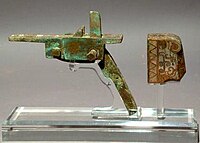
Photo from wikipedia
This paper presents room temperature nanoseconds to milliseconds time‐resolved spectra and kinetics of the intermediate states and species of bovine and carp fish rhodopsin visual pigments, which also contained ~5%… Click to show full abstract
This paper presents room temperature nanoseconds to milliseconds time‐resolved spectra and kinetics of the intermediate states and species of bovine and carp fish rhodopsin visual pigments, which also contained ~5% cone pigments. The nanoseconds to milliseconds range cover all the major intermediates in the visual phototransduction process except the formation of bathorhodopsin intermediate which occurs at the femtosecond time scale. The dynamics of these visual pigment intermediates are initiated by excitation with a 532 nm nanosecond laser pulse. The recorded differences between bovine and carp rhodopsin time‐resolved spectra of the formation and decay kinetics of their intermediates are presented and discussed. The data show that the carp samples batho intermediate decays faster, nearly by a factor of three, compared to the bovine samples. The formation and decay spectra and kinetics of rhodopsin outer segments and extracted rhodopsin inserted in buffer solution were found to be identical, with very small differences between them in the decay lifetimes of bathorhodopsin and formation of lumirhodopsin.
Journal Title: Photochemistry and Photobiology
Year Published: 2022
Link to full text (if available)
Share on Social Media: Sign Up to like & get
recommendations!